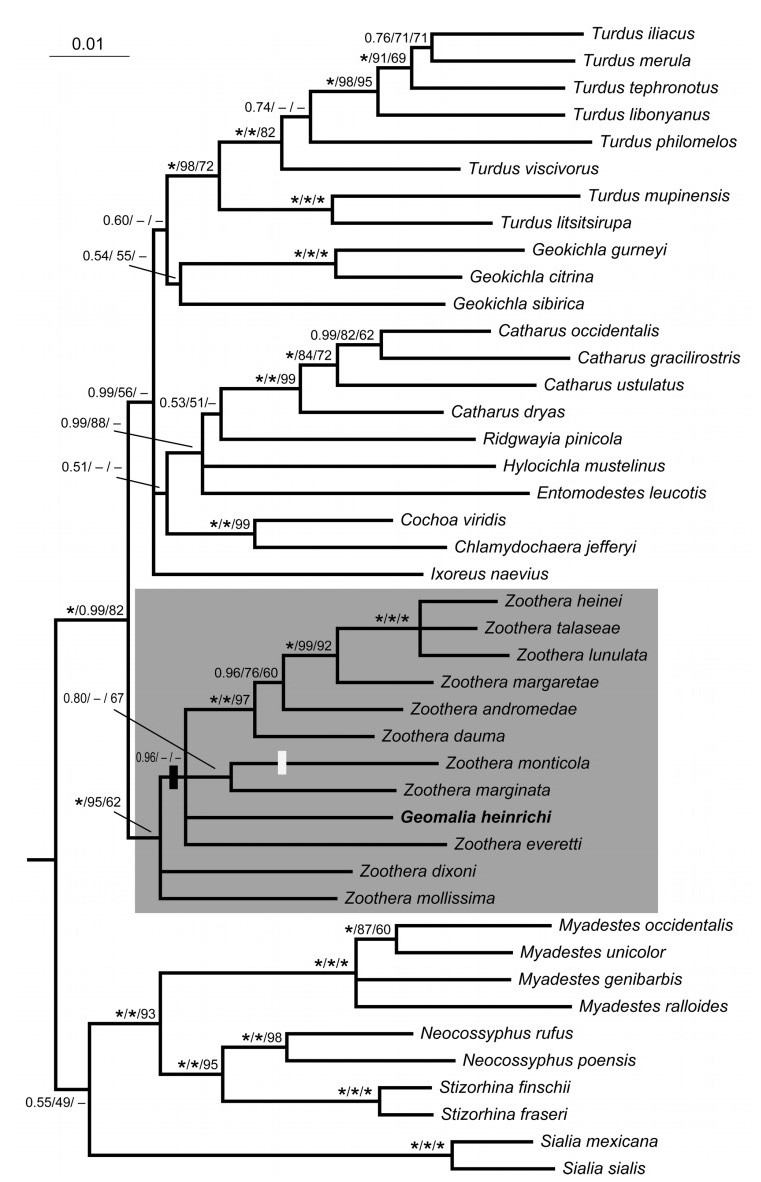Allen ES, Omland KE. 2003. Novel intron phylogeny supports plumage convergence in orioles ( Icterus). Auk, 120: 961–969.
|
Cibois A, Cracraft J. 2004. Assessing the passerine "tapestry": phylogenetic relationships of the Muscicapoidea inferred from nuclear DNA sequences. Mol Phylogenet Evol, 32: 264–273.
|
|
Clement P. 2000. Thrushes. Princeton University Press, Princeton, N.J.
|
Clements JF, Schulenberg TS, Iliff MJ, Sullivan BL, Wood CL, Roberson D. 2012. The eBird/Clements checklist of birds of the world: Version 6.7.
|
|
Coates BJ, Bishop KD. 1997. A Guide to the Birds of Wallacea. Dove Publ., Alderley, Australia.
|
|
Collar NJ. 2004. Four odd "thrushes". BirdingAsia, 1: 18–21.
|
|
Collar NJ. 2005. Family Turdidae (Thrushes), Geomalia. In: del Hoyo J, Elliott A, Christie DA (eds) Handbook of the Birds of the World (Vol. 10). Lynx Edicions, Barcelona, Spain, p 633.
|
|
Dickinson E (ed. ). 2003. The Howard and Moore Complete Checklist of the Birds of the World. 3rd ed. Helm, London.
|
Friesen VL, Congdon BC, Kidd MG, Birt TP. 1999. Polymerase chain reaction (PCR) primers for the amplification of five nuclear introns in vertebrates. Mol Ecol, 8: 2147–2149.
|
Gill F, Donsker D. 2013. IOC World Bird List (v. 3.3). . Accessed 2 March 2013.
|
|
Gu X, Fu Y-X, Li W-H. 1995. Maximum likelihood estimation of the heterogeneity of substitution rate among nucleotide sites. Mol Biol Evol, 12: 546–557.
|
Hasegawa M, Kishino Y, Yano T. 1985. Dating of the human–ape splitting by a molecular clock of mitochondrial DNA. J Mol Evol, 22: 160–174.
|
Helbig A J, Seibold I, Martens J, Wink M. 1995 Genetic differentiation and phylogenetic relationships of Bonelli's Warbler Phylloscopus bonelli and Green Warbler P. nitidus. J Avian Biol, 26: 139–153.
|
|
Holmes DA, Philipps K. 1996. The Birds of Sulawesi. Oxford University Press, Kuala Lumpur.
|
Huelsenbeck JP, Ronquist F. 2001. MrBayes: Bayesian inference of phylogeny. Bioinformatics, 17: 754–755.
|
Irestedt M, Ohlson JI, Zuccon D, Källersjö M, Ericson PGP. 2006. Nuclear DNA from old collections of avian study skins reveals the evolutionary history of the Old World suboscines (Aves, Passeriformes). Zool Scr, 35: 567–580.
|
Klicka J, Voelker G, Spellman GM. 2005. A molecular systematic revision of the true thrushes (Turdinae). Mol Phylogenet Evol, 34: 486–500.
|
Lanave C, Preparata C, Saccone C, Serio G. 1984. A new method for calculating evolutionary substitution rates. J Mol Evol, 20: 86–93.
|
|
Miller MA, Pfeiffer W, Schwartz T. 2010. Creating the CIPRES Science Gateway for inference of large phylogenetic trees in Proceedings of the Gateway Computing Environments Workshop (GCE), 14 Nov. 2010, New Orleans, LA, pp 1–8.
|
Nylander JAA, Olsson U, Alström P, Sanmartín I. 2008. Accounting for Phylogenetic Uncertainty in Biogeography: A Bayesian Approach to Dispersal-Vicariance Analysis of the Thrushes (Aves: Turdus). Syst Biol, 57: 257–268.
|
Olsson U, Alström P, Ericson PG, Sundberg P. 2005. Non-monophyletic taxa and cryptic species —evidence from a molecular phylogeny of leaf-warblers ( Phylloscopus, Aves). Mol Phylogenet Evol, 36: 261–276.
|
Posada D. 2008a. jModelTest: phylogenetic model averaging. Mol Biol Evol, 25: 1253–1256.
|
Posada D. 2008b. jModeltest. version 0.1.1. . Accessed 17 March 2013.
|
|
Ripley SD. 1952. The Thrushes: a Taxonomic Study. Postilla 13.
|
Rodríguez J, Oliver L, Marín A, Medina R. 1990. The general stochastic model of nucleotide substitution. J Theor Biol, 142: 485–501.
|
Ronquist F, Huelsenbeck JP. 2003. MrBayes 3: Bayesian phylogenetic inference under mixed models. Bioinformatics, 19: 1572–1574.
|
Sangster G, Alström P, Forsmark E, Olsson U. 2010. Multilocus phylogenetic analysis of Old World chats and flycatchers reveals extensive paraphyly at family, subfamily and genus level (Aves: Muscicapidae). Mol Phylogenet Evol, 57: 380–392.
|
|
Sibley CG, Ahlquist JE. 1990. Phylogeny and Classification of Birds: a Study of Molecular Evolution. Yale University Press, New Haven, CT.
|
Sorenson MD, Quinn TW. 1998. Numts: a challenge for avian systematics and population biology. Auk, 115: 214–221.
|
Stamatakis A, Hoover P, Rougemont J. 2008. A fast bootstrapping algorithm for the RAxML web-servers. Syst Biol, 57: 758–771.
|
Stamatakis A. 2006. RAxML-VI-HPC: Maximum Likelihoodbased phylogenetic analyses with thousands of taxa and mixed models. Bioinformatics, 22: 2688–2690.
|
|
Stresemann E. 1931. Zur ornithologie des Latimodjong-Gebirges in südlichen Central-Celebes. Orn Monatsb, 39: 7–14.
|
Stresemann E. 1940. Die Vögel von Celebes. Teil Ⅲ. Systematik und Biologie. J Ornithol, 88: 139.
|
|
Swofford DL. 2001. PAUP*: Phylogenetic Analysis Using Parsimony (* and other methods). Version 4.08b. Sinauer Associates, Sunderland, MA.
|
|
Tavaré S. 1986. Some probabilistic and statistical problems on the analysis of DNA sequences. Lec Math Life Sci, 17: 57–86.
|
Voelker G, Klicka J. 2008. Systematics of Zoothera thrushes, and a synthesis of true thrush molecular systematic relationships. Mol Phylogenet Evol, 49: 377–381.
|
Voelker G, Rohwer S, Bowie RCK, Outlaw DC. 2007. Molecular systematics of a speciose, cosmopolitan songbird genus: defining the limits of, and relationships among, the Turdus thrushes. Mol Phylogenet Evol, 42: 422–434.
|
|
White CMN, Bruce MD. 1986. The Birds of Wallacea. B.O.U. Check-list No. 7. B.O.U., London.
|
Yang Z. 1994. Maximum likelihood phylogenetic estimation from DNA sequences with variable rates over sites: approximate methods. J Mol Evol, 39: 306–314.
|



 DownLoad:
DownLoad:






 Email Alerts
Email Alerts RSS Feeds
RSS Feeds